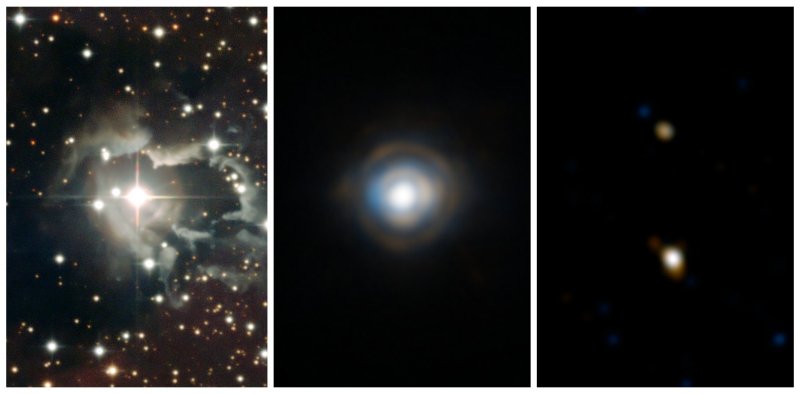B[e] stars are stars of spectral type B, with emission lines in their spectra, hence the "e". They are surrounded by a large amount of dust.
The image was obtained with the Wide Field Imager (WFI) attached to the MPG/ESO 2.2-meter telescope at the 2400-metre-high La Silla Observatory in Chile. The image shows the extended nebula of gas and dust that reflects the light from the star. The central star's wind appears to have shaped the nebula, leaving bright, ragged tendrils of gas and dust. These features seem to indicate that there are regular ejections of matter from the star every 15 to 50 years.

The star HD 87643 is at the center of the extended nebula of dust and gas on the first image, obtained with the Wide Field Imager on the ESO/MPG 2.2-metre telescope on La Silla. The central panel is a zoom on the star obtained with NACO on ESO's VLT on Paranal. The last panel zooms further , showing an image obtained with the AMBER instrument making use of three telescopes of the VLTI. The field of view of this last panel is less than one pixel of the first image. Credit: ESO/F. Millour et al.
A team of astronomers, led by Florentin Millour, has studied the star HD 87643 in great detail, using several of ESO's telescopes. Apart from the WFI, the team also used ESO's Very Large Telescope (VLT) at Paranal.
At the VLT, the astronomers used the NACO adaptive optics instrument, allowing them to obtain an image of the star free from the blurring effect of the atmosphere. To probe the object further, the team then obtained an image with the Very Large Telescope Interferometer (VLTI).
This small sequence zooms-in on the double star HD 87643, which was imaged in great detail by several of ESO's telescopes, including ESO's Very Large Telescope Interferometer (VLTI). HD 87643, in the constellation of Carina (the Keel), is located 4900 light-years away. Note that the images are drawn to scale. Credit: ESO, Digitized Sky Survey 2 and A. Fujii.
The sheer range of this set of observations, from the panoramic WFI image to the fine detail of the VLTI observations, corresponds to a zoom-in factor of 60 000 between the two extremes. The astronomers found that HD 87643 has a companion located at about 50 times the Earth–Sun distance and is embedded in a compact dust shell. The two stars probably orbit each other in a period between 20 and 50 years. A dusty disc may also be surrounding the two stars.
The presence of the companion could be an explanation for the regular ejection of matter from the star and the formation of the nebula: as the companion moves on a highly elliptical orbit, it would regularly come very close to HD 87643, triggering an ejection.
Article: F. Millour et al., Astronomy and Astrophysics, 'A binary engine fueling HD 87643’s complex circumstellar environment using AMBER/VLTI imaging'




Comments